The Big Picture
By Colin Twiggs
January 16, 2007 5:00 a.m. ET (9:00 p.m. AEDT)
These extracts from my daily trading diary are for educational purposes and should not be interpreted as investment advice. Full terms and conditions can be found at Terms of Use.
The Big Picture
One of the biggest failures of the discounted cash flow model,
used by many investment institutions to value future cash
flows, is the use of long-term risk-free (treasury) yields
instead of a stable bench-mark rate. When yields are low,
valuations are higher, and when yields rise, values decline.
Rising long-term yields can have a profound impact on equity
markets.
Ten-year treasury yields remain in an up-trend, having
respected the 3-year trendline. Expect another test of
resistance at 5.25%.
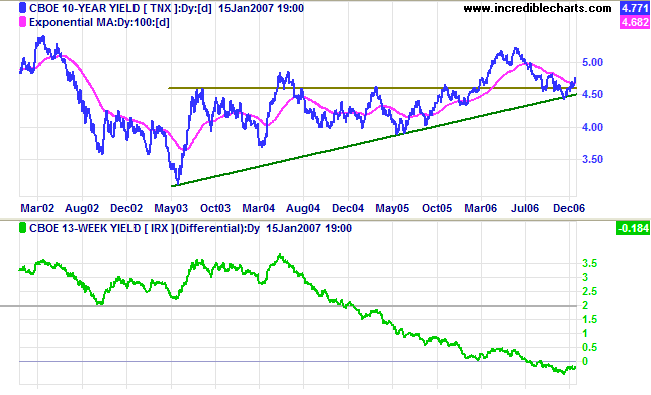
The yield differential (10-year minus 13-week treasury yields) remains negative, warning of long-term pressure on banking margins and a possible down-turn.
Equity Markets
There is no indication as yet that the current bearish divergence on Twiggs Money Flow warns of anything more than a secondary correction for the Dow Industrial Average, but we need to remain vigilant.
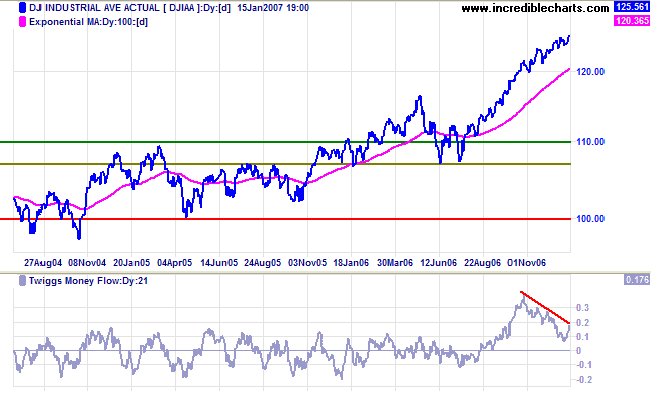
Gold
Spot gold is in a large triangular consolidation which started
with the high of May 2006. The metal has so far respected
support at the mid-point of $600. A fall below this level would
signal a test of primary support at $560. Breakout above $650,
on the other hand, would signal resumption of the primary
up-trend.
Crude oil prices below $55 are likely to reduce demand for
gold, while a weaker dollar would increase demand; two opposing
forces that may offset each other.
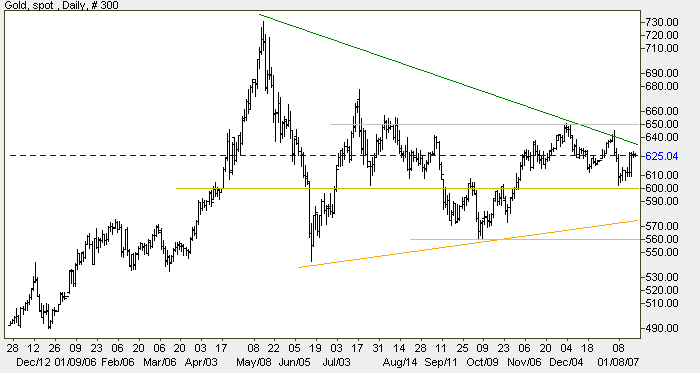
Source: Netdania
Crude Oil
Crude broke through support at $55/barrel, signaling a long-term down-trend. The next major support level is $40. Recovery to above $55 appears less likely, but would indicate a weak down-trend and possible bear trap.
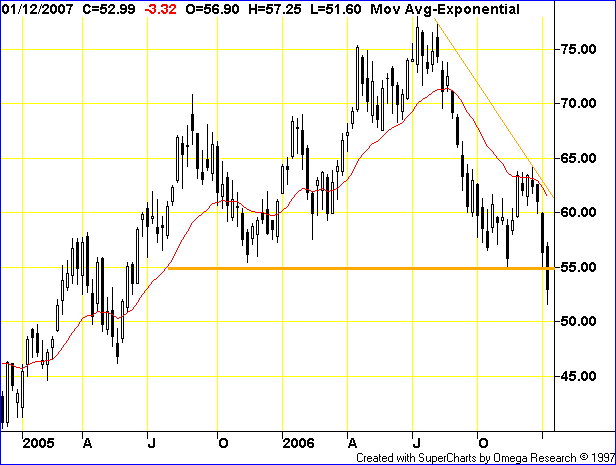
Currencies
The euro penetrated support at $1.30, indicating a slower trend. If the retracement respects the (green) upward trendline, the up-trend will be considered healthy. A fall below $1.25, though less likely, would signal reversal.
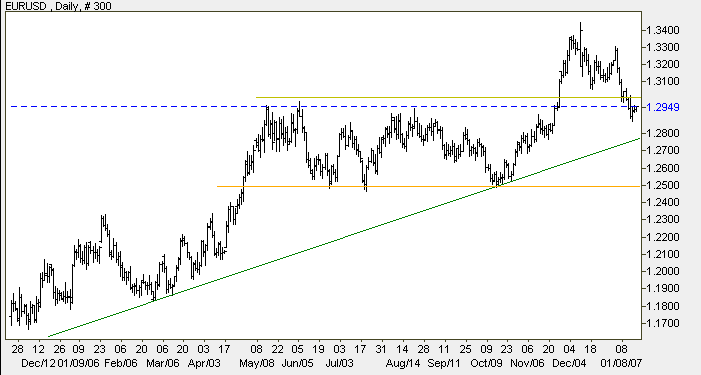
Source: Netdania
The dollar is in a long-term bearish descending triangle against the yen, with support at 100. A breakout above the December 2005 high of 121, however, would be a strong bull signal for the dollar. Failure to breakout would most likely form a bullish ascending triangle between the (green) upward trendline and resistance at 121. A fall below 115 is less likely at this stage, but would signal a test of long-term support at 100.
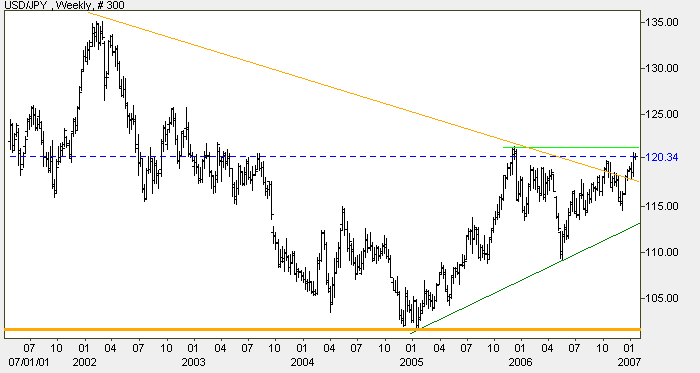
Source: Netdania
Wright Model
Probability of recession in the next four quarters remains at 45 per cent according to the Wright Model.
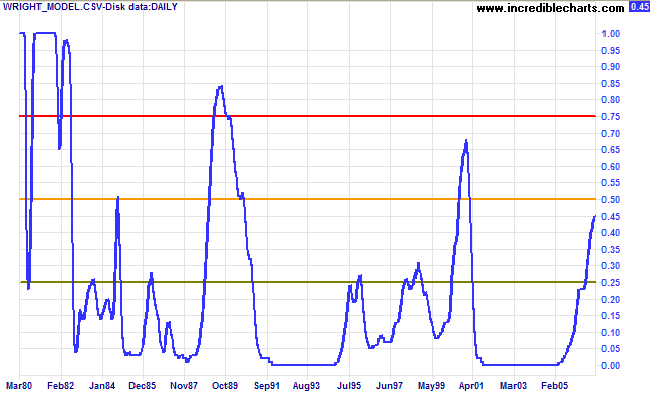
There is some evidence that the Wright model may understate the probability of recession in a low interest rate environment (as at present). The model emphasizes the nominal level of short-term interest rates and ignores whether these rates are rising or falling. It also does not adequately explain the behavior of the market during the 1966 and 2001 recessions, when interest rates were low.
He who knows others is wise;
He who know himself is enlightened.
~ Lao Tzu
Technical Analysis and PredictionsI believe that Technical Analysis should not be used to make predictions because we never know the outcome of a particular pattern or series of events with 100 per cent certainty. The best that we can hope to achieve is a probability of around 80 per cent for any particular outcome: something unexpected will occur at least one in five times.My approach is to assign probabilities to each possible outcome. Assigning actual percentages would imply a degree of precision which, most of the time, is unachievable. Terms used are more general: "this is a strong signal"; "this is likely"; "expect this to follow"; "this is less likely to occur"; "this is unlikely"; and so on. Bear in mind that there are times, especially when the market is in equilibrium, when we may face several scenarios with fairly even probabilities. Analysis is also separated into three time frames: short, medium and long-term. While one time frame may be clear, another could be uncertain. Obviously, we have the greatest chance of success when all three time frames are clear. The market is a dynamic system. I often compare trading to a military operation, not because of its' oppositional nature, but because of the complexity, the continual uncertainty created by conflicting intelligence and the element of chance that can disrupt even the best made plans. Prepare thoroughly, but allow for the unexpected. The formula is simple: trade when probabilities are in your favor; apply proper risk (money) management; and you will succeed. For further background, please read About The Trading Diary. |

Author: Colin Twiggs is a former investment banker with almost 40 years of experience in financial markets. He co-founded Incredible Charts and writes the popular Trading Diary and Patient Investor newsletters.
Using a top-down approach, Colin identifies key macro trends in the global economy before evaluating selected opportunities using a combination of fundamental and technical analysis.
Focusing on interest rates and financial market liquidity as primary drivers of the economic cycle, he warned of the 2008/2009 and 2020 bear markets well ahead of actual events.
He founded PVT Capital (AFSL No. 546090) in May 2023, which offers investment strategy and advice to wholesale clients.
